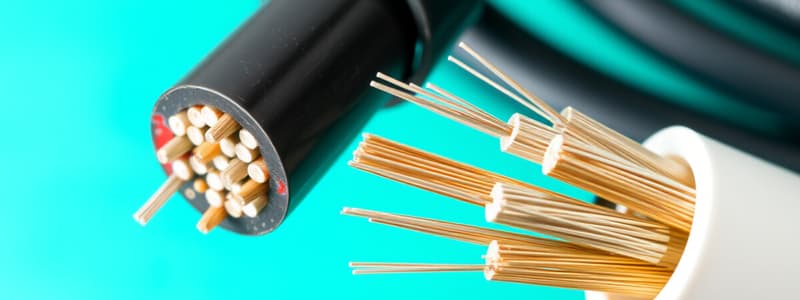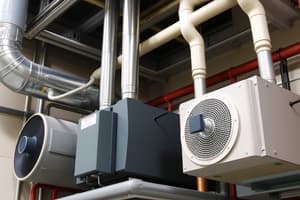Podcast
Questions and Answers
What is the primary function of a conductor in a cable?
What is the primary function of a conductor in a cable?
- To provide mechanical strength
- To minimize heat generation
- To insulate against electric shock
- To allow current to flow easily (correct)
Which of the following materials is most commonly used for conductors in electrical cables?
Which of the following materials is most commonly used for conductors in electrical cables?
- Aluminium
- Silver
- Gold
- Copper (correct)
What characteristic should NOT be associated with a good insulator?
What characteristic should NOT be associated with a good insulator?
- Minimization of electric shock risk
- Ability to confine current
- High electrical resistance
- Mechanical flexibility (correct)
Which of the following materials is commonly used as insulation for cable conductors?
Which of the following materials is commonly used as insulation for cable conductors?
What is one of the three main parts of a cable?
What is one of the three main parts of a cable?
Which type of cable is named after its insulation material?
Which type of cable is named after its insulation material?
What is a primary function of insulation in electrical cables?
What is a primary function of insulation in electrical cables?
Which of the following is NOT a characteristic of a good conductor?
Which of the following is NOT a characteristic of a good conductor?
What is the primary purpose of an additional sheath on electrical cables?
What is the primary purpose of an additional sheath on electrical cables?
What does the term 'stranding' refer to in the context of electrical cables?
What does the term 'stranding' refer to in the context of electrical cables?
How is the size of a cable typically specified in terms of stranding?
How is the size of a cable typically specified in terms of stranding?
Which of the following is NOT a common size for residential wiring cables?
Which of the following is NOT a common size for residential wiring cables?
What material is often used for armouring cables to provide mechanical protection?
What material is often used for armouring cables to provide mechanical protection?
Why are conductors often stranded in electrical cables?
Why are conductors often stranded in electrical cables?
What is the main reason for identifying conductors at their terminations?
What is the main reason for identifying conductors at their terminations?
What material is most commonly used for insulation in electrical cables due to its properties?
What material is most commonly used for insulation in electrical cables due to its properties?
What characteristic is essential for a conductor in electrical cables?
What characteristic is essential for a conductor in electrical cables?
Which of the following materials is considered the best conductor due to its low resistivity?
Which of the following materials is considered the best conductor due to its low resistivity?
Which type of insulation is best suited for high voltage applications?
Which type of insulation is best suited for high voltage applications?
What is the primary purpose of using an insulator in a cable?
What is the primary purpose of using an insulator in a cable?
Which of the following is NOT a common application for Bakelite as an insulating material?
Which of the following is NOT a common application for Bakelite as an insulating material?
Which of the following materials is often used for the insulation of heating elements?
Which of the following materials is often used for the insulation of heating elements?
What factor is not typically considered when identifying the type of cable based on its insulation?
What factor is not typically considered when identifying the type of cable based on its insulation?
What is the primary advantage of having both sheathing and armouring on electrical cables?
What is the primary advantage of having both sheathing and armouring on electrical cables?
In cable sizing, what does the term '7/0.67' signify?
In cable sizing, what does the term '7/0.67' signify?
What material is often used to provide mechanical protection in the armouring of cables?
What material is often used to provide mechanical protection in the armouring of cables?
Which of the following best describes the purpose of stranding in conductors?
Which of the following best describes the purpose of stranding in conductors?
How does the nominal cross-sectional area of a conductor affect its functionality?
How does the nominal cross-sectional area of a conductor affect its functionality?
What is the main benefit of proper identification of conductors throughout their length?
What is the main benefit of proper identification of conductors throughout their length?
Which of the following cable sizes is typically NOT used for residential wiring?
Which of the following cable sizes is typically NOT used for residential wiring?
Flashcards are hidden until you start studying
Study Notes
Cable Functions and Components
- Cables serve as electrical pathways, facilitating the flow of current.
- Composed of at least two main parts: a conductor and an insulator.
- Common cable types include those named after their insulator materials, such as PVC cables.
Conductor Characteristics
- Conductors enable the easy flow of electricity and should have:
- Low electrical resistance.
- Mechanical strength and flexibility.
- Cost-effectiveness.
- Copper is preferred for its strength and conductivity, despite silver having the best conductivity.
Insulator Functions
- Insulators have high electrical resistance, confining current to conductors.
- Their primary role is to minimize risks of electric shock and fire.
- Insulation materials vary based on voltage and environmental conditions, including:
- Bakelite for accessories.
- Ceramic for switchgear support.
- PVC for cable insulation.
- Rubber and paper for general insulation.
Mechanical Protection of Cables
- Many cables include protective sheaths or armouring for physical security during installation and operation.
- Sheathing materials may include PVC, copper, or aluminum, protecting against moisture.
- Armouring involves wrapping cables in metal, often steel wire or tape, adding additional protection.
Stranding Process
- Stranding divides conductors into smaller twisted wires, forming a flexible core.
- This design enhances handling and maneuverability.
Cable Sizing
- Cable size can be described by:
- Strand quantity and diameter (e.g., 7/0.67: seven strands, each 0.67 mm diameter).
- Nominal cross-sectional area (e.g., 2.5 mm²).
- Common residential cable sizes include 1.5 mm², 2.5 mm², 4 mm², 6 mm², and 10 mm².
- The size determines the cable's current-carrying capacity.
Conductor Identification
- Proper identification of conductors at terminations and along their lengths ensures ease of connection and safety.
Cable Functions and Components
- Cables serve as electrical pathways, facilitating the flow of current.
- Composed of at least two main parts: a conductor and an insulator.
- Common cable types include those named after their insulator materials, such as PVC cables.
Conductor Characteristics
- Conductors enable the easy flow of electricity and should have:
- Low electrical resistance.
- Mechanical strength and flexibility.
- Cost-effectiveness.
- Copper is preferred for its strength and conductivity, despite silver having the best conductivity.
Insulator Functions
- Insulators have high electrical resistance, confining current to conductors.
- Their primary role is to minimize risks of electric shock and fire.
- Insulation materials vary based on voltage and environmental conditions, including:
- Bakelite for accessories.
- Ceramic for switchgear support.
- PVC for cable insulation.
- Rubber and paper for general insulation.
Mechanical Protection of Cables
- Many cables include protective sheaths or armouring for physical security during installation and operation.
- Sheathing materials may include PVC, copper, or aluminum, protecting against moisture.
- Armouring involves wrapping cables in metal, often steel wire or tape, adding additional protection.
Stranding Process
- Stranding divides conductors into smaller twisted wires, forming a flexible core.
- This design enhances handling and maneuverability.
Cable Sizing
- Cable size can be described by:
- Strand quantity and diameter (e.g., 7/0.67: seven strands, each 0.67 mm diameter).
- Nominal cross-sectional area (e.g., 2.5 mm²).
- Common residential cable sizes include 1.5 mm², 2.5 mm², 4 mm², 6 mm², and 10 mm².
- The size determines the cable's current-carrying capacity.
Conductor Identification
- Proper identification of conductors at terminations and along their lengths ensures ease of connection and safety.
Studying That Suits You
Use AI to generate personalized quizzes and flashcards to suit your learning preferences.



